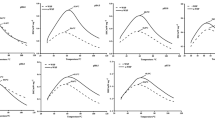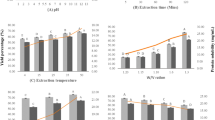Abstract
The solubility of meat protein of croaker and jack mackerel was significantly affected by pH shifting. The protein yield of alkali-aided processing is higher than those of conventional and acid-aided processing. The addition of sarcoplasmic protein increases the breaking force and deformation value. The breaking force of recovered protein gel from alkali-aided processing is decreased by the addition of NaCl. Sodium dodecyl sulfate-polyacrylamide gel electrophoresis (SDS-PAGE) revealed that fish protein of alkali is similar to that at pH7.0. Alkali-aided processing for recovering fish protein is a valuable method for increasing the utilization of frozen and pelagic fishes and for making kamaboko products.
Similar content being viewed by others
References
Choi, Y.J., and J.W. Park, 2002. Acid-aided protein recovery from enzyme-rich Pacific whiting. J. Food Sci., 67: 2 962–2 967.
Hashimoto, A., N. Katoh, H. Nozaki, and K. Arai, 1985. Inhibiting effect of various factors in muscle Pacific mackerel on gel forming ability. Nippon Suisan Gakkaishi, 51: 425–432.
Hultin, H.O., and S.D. Kelleher, 1999. Process for isolating a protein composition from a muscle source and protein composition. Advanced Protein Technologies, U. S. patent 6005073.
Kim, Y.S., J.W. Park, and Y.J. Choi, 2003. New approaches for the effective recovery of fish proteins and their physicochemical characteristics. Fish. Sci., 69: 1231–1239.
Laemmli, U.K., 1970. Cleavage of structural proteins during assembly of the head of bacteriophage T4. Nature, 227: 680–685.
Lowey, O. H., N. J. Rosebrough, A.I. Farr, and R. J. Randall, 1951. Protein measurement with Folin phenol reagent. J. Biol. Chem., 193: 256–275.
Morioka, K., and Y. Shimizu, 1990. Contribution of sarcoplasmic proteins gel formation of fish meat. Nippon Suisan Gakkaishi, 56: 929–933 (in Japanese).
Morioka, K., and Y. Shimizu, 1993. Relationship between the heat-gelling property and composition of fish sarcoplasmic proteins. Nippon Suisan Gakkaishi, 59: 1 631 (in Japanese).
Morioka, K., K. Kuashima, and Y. Shimizu, 1992. Heat-gelling properties of fish sarcoplasmic protein. Nippon Suisan Gakkaishi, 58: 767–772 (in Japanese).
Ninomiya, K., T. Ookawa, T. Tsuchiya, and J.J. Matsumoto, 1990. Concentration of fish waste soluble protein and its gelation properties. Nippon Suisan Gakkaishi, 56: 1 641 -1 645 (in Japanese).
Okada, M., 1964. Effect of washing on the jelly forming ability of fish meat. Nippon Suisan Gakkaishi, 30: 255–261.
Park, J. W., T. M. Lin, and J. Yongsawatdigul, 1997. New development in manufacturing of surimi and surimi seafood. Food Rev. Int., 13: 577–610.
Park, J. W., 1994. Functional protein additives in surimi gels. J. Food Sci., 59: 525–527.
Prerez-Mateos, M., P.M. Amato, and T.C. Lanier, 2004. Gelling properties of Atlantic croaker surimi processed by acid or alkaline solubilization. J. Food Sci., 69: FCT328-FCT333.
Roussel, H., and J.C. Cheftel, 1990. Mechanism of gelation of sardine proteins: influence of thermal processing and of various additives on the texture and protein solubility of kamaboko gels. Int. J. Food Sci. Technol., 25: 260–280.
Shimizu, Y., and F. Nishioka, 1974. Interactions between horse mackerel actomyosin and sarcoplasmic proteins during heat coagulation. Nippon Suisan Gakkaishi, 40: 231–234.
Toyoda, K., I. Kimura, T. Fujita, S.F. Noguchi, and C.M. Lee, 1992. The surimi manufacturing process. In: Surimi Technology. Lanier, T. C., and C.M. Lee, eds., Marcel Dekker Inc, New York, 79–112.
Umemoto, S., 1966. A modified method for estimation of fish muscle protein by Biurte method. Nippon Suisan Gakkaishi, 32: 427–435.
Yongsawatdigul, J., and W.J. Park, 2001. Gelation characteristics of alkaline and acid solubilization of fish muscle proteins (abstract). In: IFT Annual Meeting Book of Abstracts, 2001 June 23–27, New Orleans, La. Chicago, 251.
Author information
Authors and Affiliations
Corresponding author
Rights and permissions
About this article
Cite this article
Choi, J.Y., Kim, JS. Fish protein recovered using ph shifting method and its physicochemical properties. J Ocean Univ. China 4, 224–228 (2005). https://doi.org/10.1007/s11802-005-0037-z
Received:
Accepted:
Issue Date:
DOI: https://doi.org/10.1007/s11802-005-0037-z




